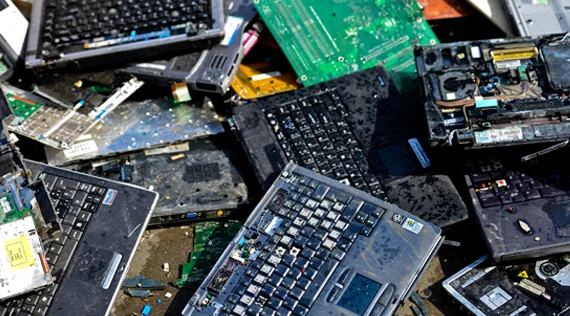Traditional circuit boards are manufactured from resin, glass fibers, and metal wiring, making them somewhat bulky and harder to recycle.
SEATTLE (Scrap Monster): While we all love technology that makes life easier, the waste created from cast-off devices is doing the Earth no favors. E-waste is the fastest growing category of domestic trash, with over 50 million metric tons being produced each year. That equates to roughly 15 pounds of e-waste per person annually. Now, researchers at the University of New York at Binghamton have brainstormed a way to make single-use electronics more environmentally-friendly with biodegradable paper circuit boards.
“Humanity’s excessive production of material waste poses a critical environmental threat, and the problem is only escalating, especially in the past few decades with the rapid development of powerful electronic tools and persistent consumer desire to upgrade to the newest available technology,” the team, led by Professor Soekheun Choi, wrote in a paper published in the ASC Applied Materials and Interfaces journal.
“The poor disposability of electronics,” the researchers continue, “is especially an issue for the newly arising field of single-use devices and sensors, which are often used to evaluate human health and monitor environmental conditions, and for other novel applications. Though impressive in terms of function and convenience, usage of conventional electronic components in these applications would inflict an immense surge in waste and result in higher costs.”
Traditional circuit boards are manufactured from resin, glass fibers, and metal wiring, making them somewhat bulky and harder to recycle. That means that millions of single-use circuits in things like personal wearable devices, point-of-care medical devices, and environmental monitors simply get tossed in the trash every day.
In response to this issue, the team — assembled from the University’s Bioelectrics and Microsystems Laboratory in the Department of Electrical and Computer Engineering — turned to an exercise in “papertronics.” They created a single-use, amplifier-type electronic circuit board made from renewable and biodegradable materials like paper and wax.
They started by printing out electronic channels using wax onto a single sheet of filter paper. The wax was heated to 266 degrees Fahrenheit for two minutes so it could soak completely through the paper. The next step was to fill in all the areas not covered in wax with both semi-conductive and conductive ink. The team then screen-printed conductive metal components onto the paper before bonding the layers together with Thru-hole technology. Lastly, they cast a gel-based electrolyte at 140 degrees Fahrenheit for 10 minutes onto the sheet.
Courtesy: www.news.yahoo.com
Image and article originally from www.scrapmonster.com. Read the original article here.

